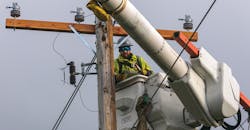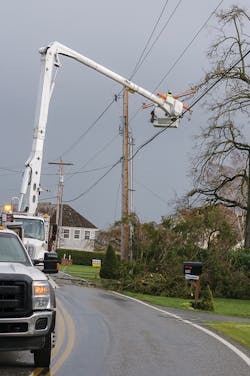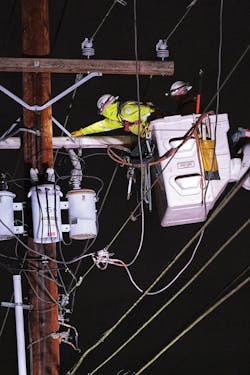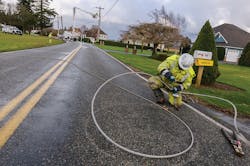Winter Wind Storms Knock Out Power in Washington
Western Washington is known as the land of wind and trees. In its service area, Puget Sound Energy (PSE) is said to have six times the number of trees per mile of line than other utilities in other parts of the country. During high winds and severe weather events, these tall trees often topple onto power lines, inflicting widespread power outages.
Case in point: In just a three-and-a-half week time frame, the utility responded to three separate wind storms in December and early January. The winds reached gusts of 60 mph, causing damage to infrastructure and knocking out power to 846,000 out of its 1.2 million customers between all three storms.
All three of the windstorms inflicted a similar level of destruction, but the number of customers affected escalated with each severe weather event (see sidebar, “Storm Snapshot”). The first storm hit in mid-December and all customers were restored after two days, the next storm started on Dec. 20 and all customers were restored after four days, and the final storm surged into the service territory on Jan. 6 and all customers were restored in three and a half days.
Assessing Damage
During the wind storms, trees landed on power lines, poles, transformers and other structures. The falling vegetation not only blocked residential roads, but also obstructed freeways and damaged cars, homes and buildings.
Due to their weight and size, the falling trees ripped down the power lines and also tore down adjacent poles and associated equipment. In turn, the lights went out across much of PSE’s service area.
Rather than sending first responders and other line workers out in the peak of the storm, PSE lived by its mantra, “Safety is our top priority. Nobody gets hurt today.” Once the winds died down and it was safe to begin restoration, the utility deployed its front-line employees to the field.
In past storms, PSE has conducted damage assessments through ground and aerial inspections, which can be conducted via helicopters or drones under specific conditions. During the recent wind storm events field workers drove to the storm-impacted locations and focused on assessing the damage. Areas with critical structure or downed tree situations were assessed and prioritized in order to clear roadways for public safety. Field crews worked with local jurisdictions to remove the vegetation and clear
the streets.
In addition, PSE turned to its vegetation management contractor, Asplundh Tree Services, to respond to the storm. By having the same contractor handle its vegetation management program and its storm response services, PSE has a consistent set of resources familiar with the utility’s procedures and system. To maximize the productivity of its crews PSE makes extensive usage of Asplundh’s tree trimming crews, who work with line repair crews to clear a path for restoration.
Managing Vegetation
Due to the large amount of trees in its service area, PSE has learned to co-exist with trees through a robust vegetation management program.
For the last several years, the utility has installed “tree wire” in targeted areas to prevent tree-related outages due to falling branches and limbs. The line workers install this tough, coated wire in regions with a high concentration of trees near power lines.
In addition, the utility trims all of its overhead lines on regular cycles, which depends on the specific region, voltage class of the line and species of tree. The utility’s lines are commonly on a one-, three-, four- or six-year cycle.
The utility also follows a practice called “hot spotting.” If it gets reports of a tree that is in danger of hitting the line, the Asplundh tree trimming crews can take care of it, regardless of the time of year and the spot in the cycle.
Improving Power Reliability
To increase the reliability and resiliency of its power system, PSE has hardened some of its infrastructure by installing larger diameter, stronger wood poles, steel poles and “glu-laminated” poles, which are laminated pieces of wood for strength and
durability.
The company has also deployed distribution automation in parts of its electrical system. This technology allows the utility to automatically isolate a damaged section of distribution line following a fault, and then automatically switch and reconfigure the system to route power.
So far the investment in the distribution automation system has already started to make a difference. The utility has deployed close to 30 sites and is pleased with the results of this technology. The utility plans to continue deploying more sites.
Requesting Assistance
To further expedite its restoration process, PSE prioritizes its work so it can reconnect power to as many customers as possible. Next, PSE can quickly scale to the number of necessary crews through its mutual response program.
When disaster strikes and extra help is needed beyond what PSE employees and local service provider, Potelco can support, PSE often gets excellent assistance from other nearby companies, and in turn, provides it when they need help. The company gets help from other neighboring utilities such as Tacoma Power, Chelan PUD, and Avista, among others. Because PSE’s service area is so close to British Columbia, the utility often calls upon the Canadian utilities and contractors for assistance as well.
When the mutual assistance crews arrive on site, they first complete a safety orientation, which is led by a safety professional from PSE. After they get up to speed on PSE’s safety procedures and protocols, they then go out into the field, accompanied by a PSE qualified crew coordinator. This individual is well versed in PSE’s procedures and resources and stays with the mutual assistance crews the entire time they are working in the field.
Before its own field crews and mutual assistance teams even arrive on site, however, PSE is already prepared by taking a proactive approach to storm response. For example, every fall season, the utility conducts mock drills and performs outreach with its jurisdictions so that they know that the utility is ready for the winter weather.
Also, rather than only involving the operations personnel in emergency preparation and storm response, the utility takes more of a broad-based approach. If PSE expects a severe storm, it proactively notifies all of its employees with an emergency response assignment, and asks them to get ready to handle their specific task. That way, the company can swiftly scale its resources in the event of an emergency.
Through a modified incident command structure (ICS) the utility can collaborate with employees from across the company. Many internal departments successfully integrate into the ICS structure to support storm restoration efforts; including: operations, Information Technology, corporate communications, customer outreach teams and Logistics to name a few. As a storm ramps up and causes more damage, PSE can deploy additional resources and open local area coordination centers or satellite storm bases.
PSE has also created “make safe team” resources at its company. If the utility gets a report of potentially hazardous conditions to the public, such as energized wire down, PSE can deploy these resources to the scene to standby and prevent the public from encroaching too close to the hazardous location.
Customer Outreach
Another way that the utility safeguards and educates the community is through its customer outreach team. When a specific geographical area has been significantly impacted by a storm, PSE can call upon these employees to provide face-to-face support and targeted information to the local community. While the customers can access updated information and outage maps on their website, the customers often want personal interaction and the ability to access shelters or warming stations. By providing these services to its customers PSE can help keep them safe until their power is restored.
Finally, the company has an innovation program, which has helped to improve emergency response within the company. Case in point: Last year a group of PSE employees invented a damage assessment app to help field personnel quickly perform damage assessment in the field by capturing information and communicating it to the main office. This helps the team to have greater situational awareness of what has been damaged, what has been repaired, and what still needs to be assessed. The damage assessment app also gives PSE greater visibility to where its personnel are in the field.
Through these strategies, PSE can help keep their customers and the public safe, bring its field personnel home safely following storm response and get the lights on quicker for its customers.
Storm Snapshot: By the Numbers
Mother Nature escalated the severity of each wind storm that hit Puget Sound Energy’s service territory. Here’s a recap of the outage events and number of customers affected.
Storm 1: Peak number of customers out: 110,000. Total out: 172,000. Outage events: 1624.
Storm 2: Peak number of customers out: 163,000. Total out: 326,000 customers. Outage events: 3,496
Storm 3: Peak number of customers out: 235,000. Total out. 348,000 customers. Outage events: 4,150
Editor’s Note: View a photo gallery from the storm here.
About the Author
Booga Gilbertson
Booga Gilbertson ([email protected]) is the senior vice president of operations for Puget Sound Energy. She has been with the company for 25 years.



